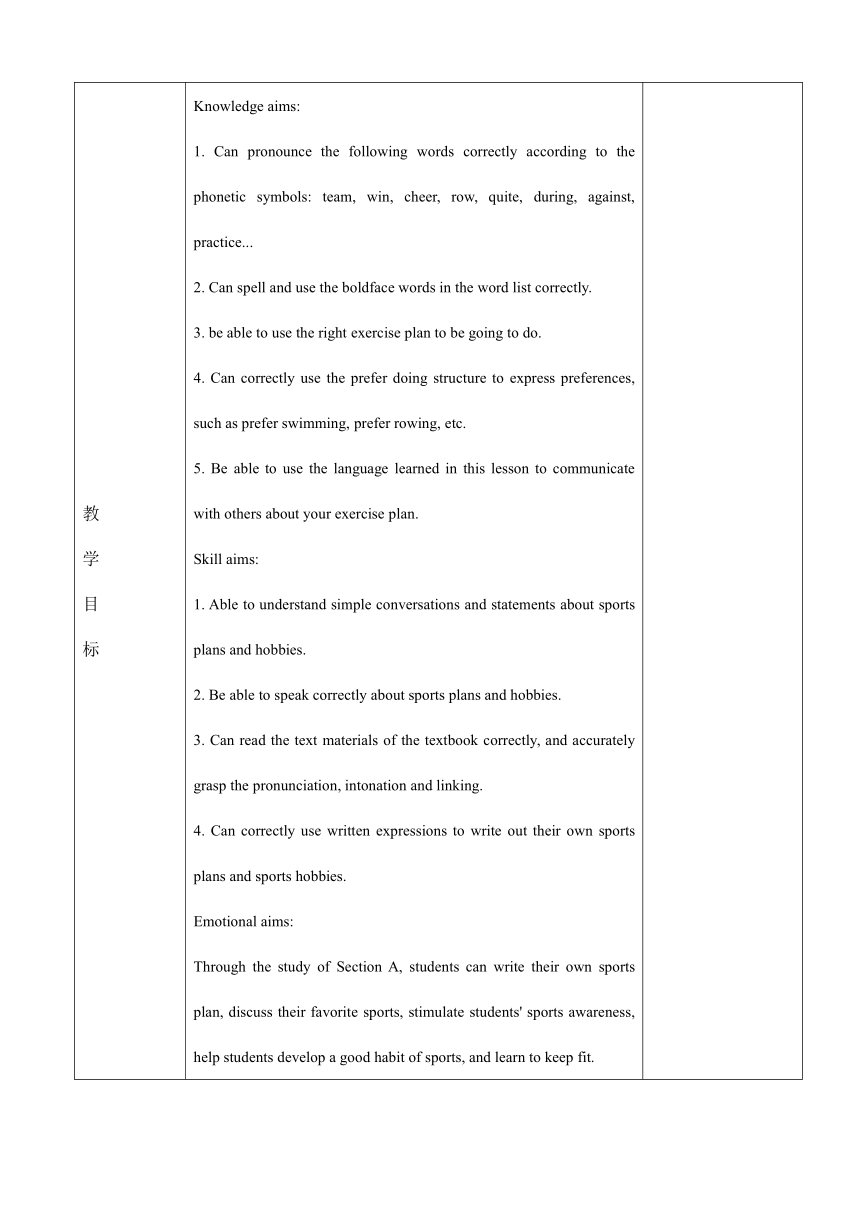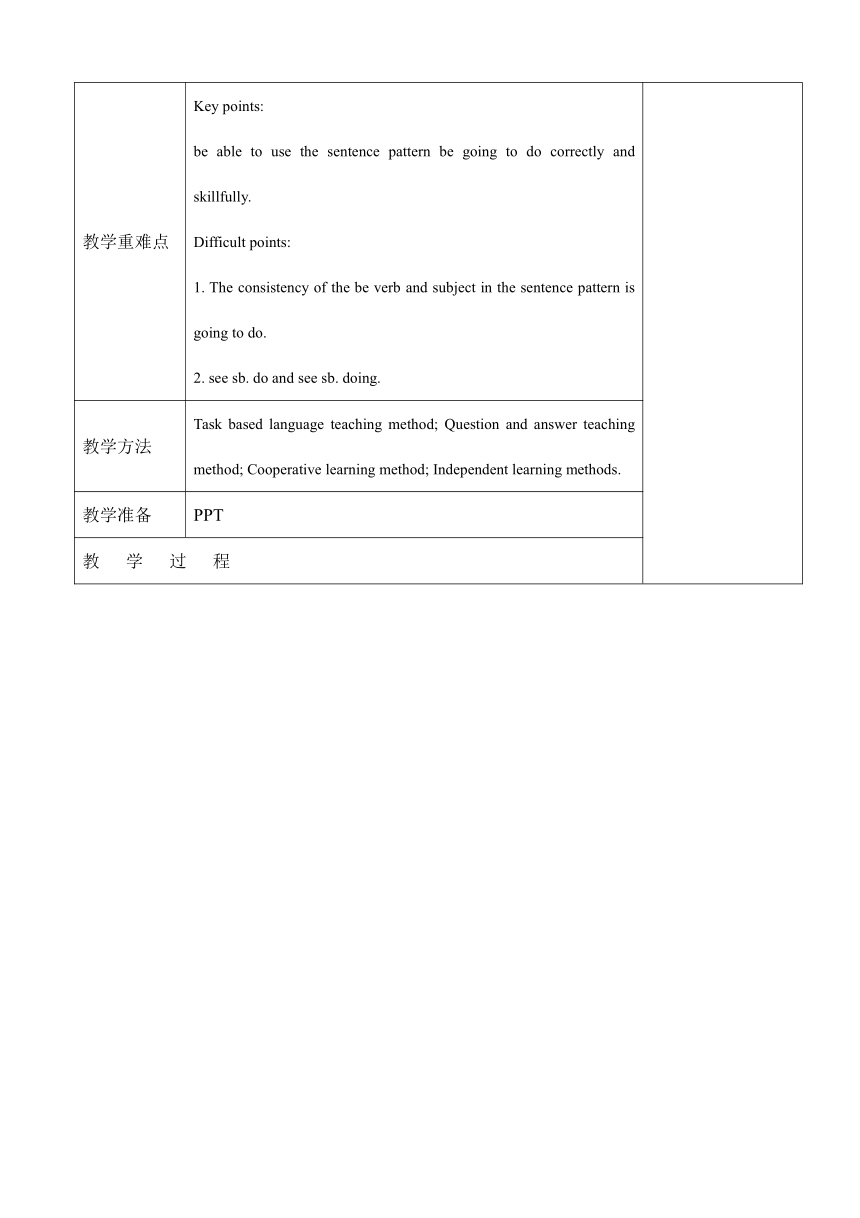仁爱版 八上Unit 1 Topic 1 I'm going to play basketball. Section A (表格式)
文档属性
| 名称 | 仁爱版 八上Unit 1 Topic 1 I'm going to play basketball. Section A (表格式) |  | |
| 格式 | doc | ||
| 文件大小 | 39.0KB | ||
| 资源类型 | 教案 | ||
| 版本资源 | 仁爱科普版 | ||
| 科目 | 英语 | ||
| 更新时间 | 2023-06-12 14:43:23 | ||
图片预览



文档简介
课 题 八年级上册教案设计Unit 1 Playing SportsTopic 1 I’m going to play basketball.Section A 二次备课
教材分析 The main activities of this class are 1a and 2.The conversation between Michael and Kangkang presents the main grammatical point of this lesson: the structure that the future tense is going to do. The key phrases are: play basketball/football, have a basketball/football game, cheer... on, win (the game), prefer doing, etc. The topic of Playing Sports is closely connected with students' life and is easy to stimulate students' interest in learning. But it is going to be difficult for students to use it correctly. Difficulty 1: The verb be does not agree with the subject (most students); Difficulty 2: Inability to correctly replace do with a concrete verb (a minority of students). Therefore, the teacher is required to guide the students to talk about their exercise plan correctly and write their exercise plan in written form based on the text content of the textbook and the actual life of the students.
教学目标 Knowledge aims:1. Can pronounce the following words correctly according to the phonetic symbols: team, win, cheer, row, quite, during, against, practice...2. Can spell and use the boldface words in the word list correctly.3. be able to use the right exercise plan to be going to do.4. Can correctly use the prefer doing structure to express preferences, such as prefer swimming, prefer rowing, etc.5. Be able to use the language learned in this lesson to communicate with others about your exercise plan.Skill aims:1. Able to understand simple conversations and statements about sports plans and hobbies.2. Be able to speak correctly about sports plans and hobbies.3. Can read the text materials of the textbook correctly, and accurately grasp the pronunciation, intonation and linking.4. Can correctly use written expressions to write out their own sports plans and sports hobbies.Emotional aims:Through the study of Section A, students can write their own sports plan, discuss their favorite sports, stimulate students' sports awareness, help students develop a good habit of sports, and learn to keep fit.
教学重难点 Key points:be able to use the sentence pattern be going to do correctly and skillfully.Difficult points:1. The consistency of the be verb and subject in the sentence pattern is going to do.2. see sb. do and see sb. doing.
教学方法 Task based language teaching method; Question and answer teaching method; Cooperative learning method; Independent learning methods.
教学准备 PPT
教 学 过 程
Step 1. Import1. Prepare students for learning.2. Show students daily language.3. Require students to design a special topic on sports and provide daily reports.4. Review:I often play table tennis in the morning.I'm also going to play table tennis tomorrow morning. The screen of playing table tennis is displayed on the computer screenStep 2. Presentation1. Write "I'm going to play table tennis." It's written on the blackboard. Ask students to replace 'playing table tennis'. The teacher displays the pictures in 2 on the computer screen, with the following words below each picturePictures: Swimming, boating, cycling, skating, playing tennis.2. Complete 1 b. The teacher introduced some content of 1b. Michael is discussing sports with Kangkang. Let's listen together and discover: What are they talking about The teacher kept playing the recording.Check 1b.3. Finish1c. The teacher presents the new words' resist 'and' practice 'in different ways.Objection: The teacher collided his/her two fists with each other.Exercise: I'm going to play table tennis. We can also say 'I'm going to practice table tennis'. The meaning of 'practice' here is' play '.4. Finish1c. The teacher played the recording twice. First time: Stop if necessary. Second time: Check the answers.Step 3. Consolidate1. Read 1a. The teacher played the recording sentence by sentence.2. The teacher gives the students 1-2 minutes to read in pairs.3. The teacher will design a competition: each group of students will first engage in pairing activities, read two pairs aloud, and then select one group from each group to engage in dialogue. In order to avoid only outstanding students performing, the teacher gave equal opportunities to different groups.The teacher explained some key and difficult points to the students:(1) The structure of being going to doThe difference between 'see... do' and 'see... doing'.5. Complete 1 d. The teacher displays 1d on the screen and checks whether the students can write new words correctly while they are writing.Step 4. Exercise1. The teacher displays the following words on the screen:Play, play, skate, swim, row, ride a bike.2. Teachers organize group activities. Divide the whole class into six groups. Each group will form their own dialogue andWrite them down and exchange them with another group.3. The teacher requires each group of students to read their own conversations one by one, and walk around the classroom to check or assist.4. The teacher kept playing the recording of 3a.When long and difficult sentences appear, the recording stops.When the answer appears, the recording stops.Step 5 SummaryThe teacher displays a summary on the screen.Step 6 AssignmentWrite an article about your own exercise plan.
教 学 反 思
教材分析 The main activities of this class are 1a and 2.The conversation between Michael and Kangkang presents the main grammatical point of this lesson: the structure that the future tense is going to do. The key phrases are: play basketball/football, have a basketball/football game, cheer... on, win (the game), prefer doing, etc. The topic of Playing Sports is closely connected with students' life and is easy to stimulate students' interest in learning. But it is going to be difficult for students to use it correctly. Difficulty 1: The verb be does not agree with the subject (most students); Difficulty 2: Inability to correctly replace do with a concrete verb (a minority of students). Therefore, the teacher is required to guide the students to talk about their exercise plan correctly and write their exercise plan in written form based on the text content of the textbook and the actual life of the students.
教学目标 Knowledge aims:1. Can pronounce the following words correctly according to the phonetic symbols: team, win, cheer, row, quite, during, against, practice...2. Can spell and use the boldface words in the word list correctly.3. be able to use the right exercise plan to be going to do.4. Can correctly use the prefer doing structure to express preferences, such as prefer swimming, prefer rowing, etc.5. Be able to use the language learned in this lesson to communicate with others about your exercise plan.Skill aims:1. Able to understand simple conversations and statements about sports plans and hobbies.2. Be able to speak correctly about sports plans and hobbies.3. Can read the text materials of the textbook correctly, and accurately grasp the pronunciation, intonation and linking.4. Can correctly use written expressions to write out their own sports plans and sports hobbies.Emotional aims:Through the study of Section A, students can write their own sports plan, discuss their favorite sports, stimulate students' sports awareness, help students develop a good habit of sports, and learn to keep fit.
教学重难点 Key points:be able to use the sentence pattern be going to do correctly and skillfully.Difficult points:1. The consistency of the be verb and subject in the sentence pattern is going to do.2. see sb. do and see sb. doing.
教学方法 Task based language teaching method; Question and answer teaching method; Cooperative learning method; Independent learning methods.
教学准备 PPT
教 学 过 程
Step 1. Import1. Prepare students for learning.2. Show students daily language.3. Require students to design a special topic on sports and provide daily reports.4. Review:I often play table tennis in the morning.I'm also going to play table tennis tomorrow morning. The screen of playing table tennis is displayed on the computer screenStep 2. Presentation1. Write "I'm going to play table tennis." It's written on the blackboard. Ask students to replace 'playing table tennis'. The teacher displays the pictures in 2 on the computer screen, with the following words below each picturePictures: Swimming, boating, cycling, skating, playing tennis.2. Complete 1 b. The teacher introduced some content of 1b. Michael is discussing sports with Kangkang. Let's listen together and discover: What are they talking about The teacher kept playing the recording.Check 1b.3. Finish1c. The teacher presents the new words' resist 'and' practice 'in different ways.Objection: The teacher collided his/her two fists with each other.Exercise: I'm going to play table tennis. We can also say 'I'm going to practice table tennis'. The meaning of 'practice' here is' play '.4. Finish1c. The teacher played the recording twice. First time: Stop if necessary. Second time: Check the answers.Step 3. Consolidate1. Read 1a. The teacher played the recording sentence by sentence.2. The teacher gives the students 1-2 minutes to read in pairs.3. The teacher will design a competition: each group of students will first engage in pairing activities, read two pairs aloud, and then select one group from each group to engage in dialogue. In order to avoid only outstanding students performing, the teacher gave equal opportunities to different groups.The teacher explained some key and difficult points to the students:(1) The structure of being going to doThe difference between 'see... do' and 'see... doing'.5. Complete 1 d. The teacher displays 1d on the screen and checks whether the students can write new words correctly while they are writing.Step 4. Exercise1. The teacher displays the following words on the screen:Play, play, skate, swim, row, ride a bike.2. Teachers organize group activities. Divide the whole class into six groups. Each group will form their own dialogue andWrite them down and exchange them with another group.3. The teacher requires each group of students to read their own conversations one by one, and walk around the classroom to check or assist.4. The teacher kept playing the recording of 3a.When long and difficult sentences appear, the recording stops.When the answer appears, the recording stops.Step 5 SummaryThe teacher displays a summary on the screen.Step 6 AssignmentWrite an article about your own exercise plan.
教 学 反 思
同课章节目录
- Unit 1 Playing Sports
- Topic 1 I'm going to play basketball.
- Topic 2 I'll kick you the ball again.
- Topic 3 The school sports meet is coming.
- Unit 2 Keeping Healthy
- Topic 1 You should brush your teeth twice a day.
- Topic 2 I must ask him to give up smoking.
- Topic 3 Must we exercise to prevent the flu?
- Unit 3 Our Hobbies
- Topic 1 What's your hobby?
- Topic 2 What sweet music!
- Topic 3 What were you doing at this time yesterday
- Unit 4 Our World
- Topic 1 What's the strongest animal on the farm?
- Topic 2 How can we protect ourselves from the eart
- Topic 3 The Internet makes the world smaller.
